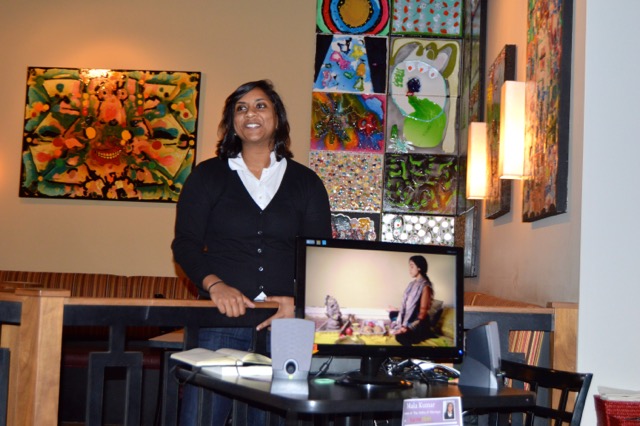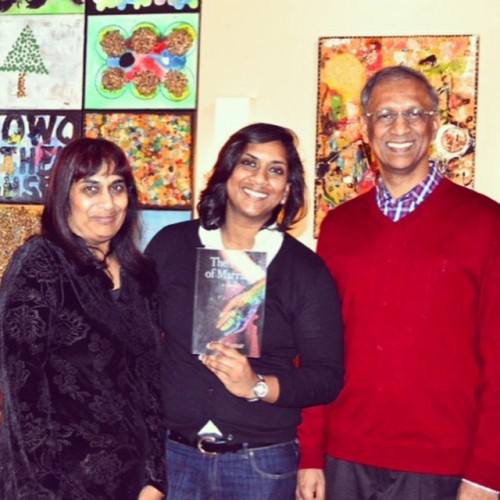
by Mala Kumar
My childhood and early adulthood predated much of the mass media storm that constantly surrounds us nowadays. Had I been born a decade later, I might have realized that as a closeted, brown, gay girl, I was in good company in my coming out planning ways. At the time, I thought I was one of the few people in the world with the need to figure out Contingency Plans A, B and C in case my parents found out I was gay and threatened to do any of the following unimaginable things:
- Send me permanently to India
- Kick me out of the house
- Try to make me straight
At the age of 10, all of my plans involved what I had at my disposal – specifically, the portion of my weekly allowance I hadn’t blown away on candy, and a three-speed bicycle. Growing up in a typical American suburb, I knew I wouldn’t get far beyond the bushes of the neighborhood, anyway. So I mostly learned to keep my mouth shut.
By 15, I had started to become more vocal about gay people existing and deserving rights. Without a car or the ability to drive, however, my plans still involved a bicycle, though a Greyhound bus ticket and the desperate need to make a living did factor in. I resolved this by learning as many bartending skills as possible with the lucrative ingredients of water, milk, juice and an occasional shot of Bombay Sapphire from my father’s dusty collection. (Don’t worry, mom, I never actually drank any of the gin.)
When I turned 20, I had achieved a few big milestones in the timeline of significant gay events. Namely, I had come out to one of my aunts and my little brother. By that point, my escape plan involved taking any job I could get straight out of school and starting my own life as best as I could. On the occasions I came back to my parents’ house for the holidays, I also had the safety net of a few select friends with cars, in case my own was not an option.
Years later, one fine day when I woke up, I realized I did not have a contingency plan…because I didn’t need one. I was an adult with a real job, a real career, a real mediocre third date scheduled for that night, and a real life in New York City. Yet somehow, I was not out to my parents and most of my family. In fact, in my timeline, not much had happened since my last contingency planning days. I had unconsciously accepted this as a normal part of my life.
[Read More: Author Mala Kumar Discusses Coming Out and the NYC DesiQ Scene]
The lack of milestones on my real-life significant gay event timeline started to weigh in on me, partially because the plot and the characters of my debut novel, “The Paths of Marriage,”, were becoming more salient. I knew I wanted to publish the book, but even if I stayed publicly closeted, there was no way the book would not bring up questions within my own family. Not wanting to cross that bridge without being able to control the speed of my bike, I decided I would come out to my parents that summer – the summer of 2012.
At that time, my brother was living and working in Madison, WI. He offered – and I quickly accepted – to come down and be a supportive sounding board. We hatched a plan of how and when I would come out, both of our parents getting targeted treatment that catered to their individual experiences and personalities. I decided to go down to my parents’ house in Virginia a few days before my brother arrived. I figured I should spend some alone time with my parents and remind them how much I loved and cared for them, and that I do sometimes regret not listening to their advice on joining med school. It was important to demonstrate that I did indeed listen to their guidance, even if that guidance was ignored.

Mom: Well, you chose an interesting career, albeit not very common.
Me: I know. I do hope to have more stability at some point, though.
Mom: Oh? Why?
Me: I guess for the same reasons as most people – financial security, to get a little dog, to find a…partner.
Mom: Really? I didn’t know that.
Me: Yeah, I mean I do eventually want to find someone…a woman. I’m gay.
Mom: Mala. I know.
I had been staring at my toast the entire time, and just barely mustered up the courage to look up at my mother as she said the last few words. The weight of the world dissipated as I saw that she was smiling. She must have researched the perfect supportive parental reaction for within a few seconds, she was at my side of the table and had wrapped me up in a giant hug. Indian families tend to show affection in limited quantities. That day, there was no lack of love that emitted from her arms.
A few days later, my mother, brother, father and I sat facing each other as we often do, for our round-robin catch-ups. We could all sense my father knew what was coming. I finally pushed out the words, “So, I’m gay.” He just stared at me, clearly not at the same loving level as my mother’s initial reaction. Understandably, growing up in 1970s India, he had little to no frame of reference of what it means to be gay. Sexual attraction did not necessarily play into the marriage equation for his era and country. It was not necessarily something a woman was allowed to express in his era and country.
My father and I mostly avoided the topic of me being gay in the year after I came out though I did my best to drop in lines to spur the conversation. For my mother, coming out was an instant gratification. With my father, I had to relate on different levels. Medically, socially, and psychologically, he could understand the theory, if not the reality. The reality was that he still couldn’t relate.
In December 2013, my parents decided to take a vacation. In another inexplicable moment, I asked my father if he would be interested in reading a copy of “The Paths of Marriage” since he’d finally have time to sit down and concentrate. By that point, my brother and mother had already read the book, and I think my father was curious. He agreed, and I ran out to get a draft copy printed.
[Read More: Book Review: ‘The Paths of Marriage’ by Mala Kumar]
I had struggled with the 100,000+ words that compose the novel for more than three years, trying to convey how a woman from 1950s India could relate her discrimination as poor and of a lower caste to her gay granddaughter’s struggles. My work paid off; my father read the entire book in just three days. The last day he was away, I got a message on my phone from him. It said four precious words:
“I get it now.”
Coming out is terrifying for many people. Having worked around the world, I know that coming out is not even an option for so many more. I am extremely lucky to have the support I do from my family. Even for me that support did not materialize overnight. I was not paranoid or incorrect as a child having contingency plans. Neither my family nor I really know what would have happened if I had come out when I was younger. All I know is that I read my own situation as best as I could. I made my own decisions on what I knew, on what I felt, not what others told me to do. I won’t claim the amazing support I have from my family will happen for everyone, but what I can say is that my family has surprised me for the positive in so many ways. I can only hope the same for you.
 Mala Kumar, the author of “The Paths of Marriage,” is an international development and ICT4D practitioner based out of New York City. She has held innovative jobs with some of the most prestigious institutions in the world, including the United Nations. Mala is excited to use her global network and The Paths of Marriage to connect people as part of a growing community and dialogue on building a more compassionate, open, and empathetic world. When not immersed in work or writing, you can find Mala exploring NYC’s culinary adventures, in an intense workout at the gym (often to mitigate the effects of said culinary adventure), planning her next international excursion, or blocking out subtitles on the latest French film. Feel free to contact her at authormala@gmail.com. Find her upcoming events on her website.
Mala Kumar, the author of “The Paths of Marriage,” is an international development and ICT4D practitioner based out of New York City. She has held innovative jobs with some of the most prestigious institutions in the world, including the United Nations. Mala is excited to use her global network and The Paths of Marriage to connect people as part of a growing community and dialogue on building a more compassionate, open, and empathetic world. When not immersed in work or writing, you can find Mala exploring NYC’s culinary adventures, in an intense workout at the gym (often to mitigate the effects of said culinary adventure), planning her next international excursion, or blocking out subtitles on the latest French film. Feel free to contact her at authormala@gmail.com. Find her upcoming events on her website.




